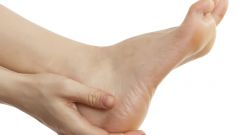A heel spur is a bone overgrowth, which is characterized by thorn or wedge shaped. It leads to pain in the foot, not only with voltage, but at rest. At the same time to detect heel spurs, and a final diagnosis is possible only with the help of x-rays.
The list of reasons that cause the appearance of a calcaneal spur, is quite extensive. It includes:
- flat feet (it is believed that in 90% of cases it is the main source of the problem);
- age-related disorders (wears out the bone tissue deteriorates and the possibility of their regeneration);
- excessive load when doing sports (non-compliance with the mode and rules of carrying out of training quickly leads to the appearance of spurs on the heels);
- overweight;
- somatic diseases (in most cases this disease, associated with metabolic disorders: diabetes mellitus, cardiovascular disease, etc.).
The first symptom indicating the development of heel spurs is pain in the heel when weight transfer. Usually it is described as a nail in the heel. There is a feeling due to the fact that bone formation starts to put pressure on the soft tissues, but this feeling is really enhanced when walking.
Pain is pretty strong in the morning, when the man gets out of bed, during the day they can go down a little, but by evening appear with even greater force. A bump on the leg over time is growing more and more.
Naturally, when it hurts to walk, first thing the man is puzzling, to whom and where to go, where to find a good doctor and how to treat. Alternatively, you can contact the district physician, who will direct you further on the necessary research and determine the expert, and should be referenced. More often, however, are advised to immediately go to a surgeon, because a problem with bone spurs, and this is an area of activity of the surgeon.
He will examine your foot and likely will send you for x-rays, because this method of research most can actually display the picture. According to the results of the examination the doctor will select the treatment method.
Heel spurs are treated by several different methods. One of them is ultrasound therapy. The method is new and still not fully described and accurate. In addition, it has a large number of contraindications.
Radiation therapy is also one of methods of struggle. For the treatment of heel blinders so x-rays are directed precisely to the spur. The efficiency of this method is quite high, and it has almost no contraindications.
Laser treatment is another option of getting rid of heel spurs. The beam passes through the tissue and relieves pain, in this case, however, the build-up without removing. Therefore required to hold regular sessions to provide quality prevention.
An excellent method to reduce the discomfort from heel spur is physical therapy. Gymnastics, massage, and various special exercises – it all helps to significantly reduce pain from spurs and makes life with her so hard.
In the most advanced cases, the use of surgical intervention.
Causes and symptoms
The list of reasons that cause the appearance of a calcaneal spur, is quite extensive. It includes:
- flat feet (it is believed that in 90% of cases it is the main source of the problem);
- age-related disorders (wears out the bone tissue deteriorates and the possibility of their regeneration);
- excessive load when doing sports (non-compliance with the mode and rules of carrying out of training quickly leads to the appearance of spurs on the heels);
- overweight;
- somatic diseases (in most cases this disease, associated with metabolic disorders: diabetes mellitus, cardiovascular disease, etc.).
The first symptom indicating the development of heel spurs is pain in the heel when weight transfer. Usually it is described as a nail in the heel. There is a feeling due to the fact that bone formation starts to put pressure on the soft tissues, but this feeling is really enhanced when walking.
The intensity of pain is impossible to judge the size of the growth. Experts say that more often it says about the location of the spurs.
Pain is pretty strong in the morning, when the man gets out of bed, during the day they can go down a little, but by evening appear with even greater force. A bump on the leg over time is growing more and more.
Treatment for heel spurs
Naturally, when it hurts to walk, first thing the man is puzzling, to whom and where to go, where to find a good doctor and how to treat. Alternatively, you can contact the district physician, who will direct you further on the necessary research and determine the expert, and should be referenced. More often, however, are advised to immediately go to a surgeon, because a problem with bone spurs, and this is an area of activity of the surgeon.
Legislation in the field of medicine have determined the sequence of entry to specialists only through a physician. That is, you first need in any case to ask the therapist to drink you the direction to the reception to the surgeon.
He will examine your foot and likely will send you for x-rays, because this method of research most can actually display the picture. According to the results of the examination the doctor will select the treatment method.
Heel spurs are treated by several different methods. One of them is ultrasound therapy. The method is new and still not fully described and accurate. In addition, it has a large number of contraindications.
Radiation therapy is also one of methods of struggle. For the treatment of heel blinders so x-rays are directed precisely to the spur. The efficiency of this method is quite high, and it has almost no contraindications.
Laser treatment is another option of getting rid of heel spurs. The beam passes through the tissue and relieves pain, in this case, however, the build-up without removing. Therefore required to hold regular sessions to provide quality prevention.
An excellent method to reduce the discomfort from heel spur is physical therapy. Gymnastics, massage, and various special exercises – it all helps to significantly reduce pain from spurs and makes life with her so hard.
In the most advanced cases, the use of surgical intervention.

